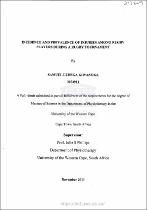| dc.description.abstract | Introduction: The world of sports is ever growing and changing, and the popularity of different sports activities has increased in these last three decades. The rugby football sport is collision sport recognized worldwide and heavily supported in Europe, Canada, the Pacific nations and Africa. Rugby at UWC is primarily an amateur sport, and in 2011, the UWC rugby team participated in the First National Bank (FNB) Varsity Shield competition for the first time in history. The sport of rugby football has been identified as being one of the highest contributors
of sports injuries at the University of the Western Cape physiotherapy clinic. Objectives: The study aimed at determining the prevalence, incidences, locations and re-occurences of rugby injuries during the FNB Varsity Shield tournament to addition, the study aimed to identify some of the preventive and management strategies used by the players during the tournament. Methods: In a prospective quantitative cohort study, data was collected with a standardized injury report form during training sessions and matches for the duration of the tournament, this instrument was tested for inter and intra-reliability, and the score of the instrument was 80%. The research instruments collected information concerning player's socio-demographic data, sustained injuries, and action taken after an injury. The Statistical Package for Social Sciences (SPSS) version 19.0 was used for analysis. Results: Thirty seven (37) rugby players participated in the study. The injury prevalence for the tournament was 86.5%, and the total incident rate was 540 injuries per 1000 playing hours. The match injury incident rate was 256 injuries per 1000 playing hours, and for training it was 266 injuries per 1000 playing hours. In addition, the Backs suffered more injuries compared to the Forwards with an injury prevalence of 56.6% (n=82) and 43/% (n=63) respectively. Most of the injuries were in the second half, with second half injury prevalence of 73oh (n= 60) compared to first half with injury prevalence of 27%o,(n=22). These
injuries were mostly minor and moderate. The lower limb suffered most of the injuries (n=88) (60.17%), and the upper leg(n=27) (18.6%) throughout the tournament. Furthermore, , there was no significant relationship between the injury site and players' position (Fischer exact:23.19, p>0.05), and the re-occurence of injuries being at 29.|Yo. The most preventive strategies used were warm-ups, stretches, and straps and taping. ln addition, the medical staff used mostly ice therapy, exercises, taping and straps to manage the injuries sustained during the tournament. Conclusion: The results of the study identified that the prevalence and incidence rates were among the highest in the world at amateur level of this sport. The re-occurence of the injuries was significantly higher than in previous studies. Furthermore, most of the injuries were minor and moderate. This showed that the work of the physiotherapist is more critical during sports events. | en_US |

